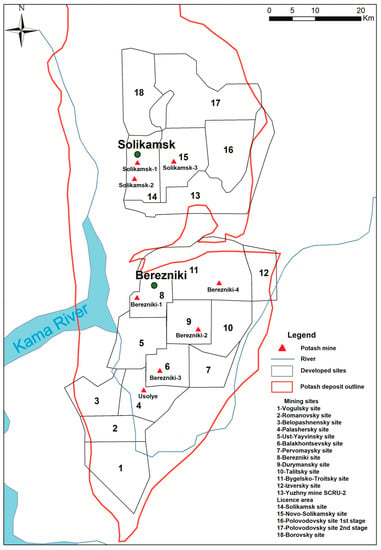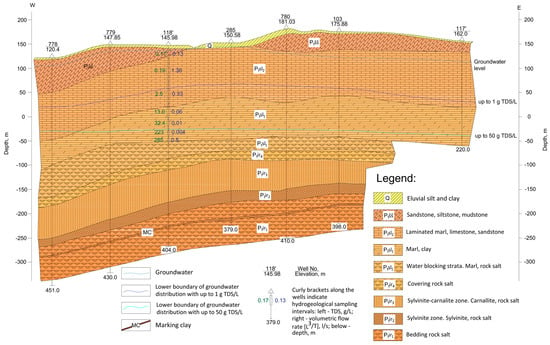Your browser does not fully support modern features. Please upgrade for a smoother experience.
Please note this is an old version of this entry, which may differ significantly from the current revision.
Subjects:
Environmental Sciences
Verkhnekamskoe potash deposit. The deposit is located in the central part of the Solikamsk depression in the Pre-Ural foredeep (Perm Krai, Russia). All the main features and problems of underground mining of water-soluble ores and potassium fertilizer production are considered using the example of one of the world’s largest potash deposits.
- potash
- potash waste
- solid and liquid waste
1. Introduction
Potassium is an essential macronutrient for plant growth and development. Along with nitrogen and phosphorus, it is one of the most important elements of plant mineral nutrition that increases biological productivity [1,2]. Modern agricultural production is heavily reliant on the quantity and quality of chemical fertilizers required to boost grain and horticultural yields in order to feed the majority of the world’s population [3,4]. Potash production has increased by 9% in the last decade, owing to increased demand in Southeast Asia [5]. Global potash production expanded due to increased production in China, Canada, Russia, and Belarus. At the same time, the increase in potash production capacity in China is linked to the need to meet domestic demand [6]. Table 1 shows data on global potash production and reserves for 2020–2021 [7].
Table 1. World potash mine production and reserves in thousand tons of K2O equivalent [7].
| Mine Production | Reserves | ||
|---|---|---|---|
| 2011 | 2021 * | ||
| Belarus | 5500 | 8000 | 750,000 |
| Brazil | 454 | 210 | 2300 |
| Canada | 11,000 | 14,000 | 1,100,000 |
| Chile | 980 | 900 | 100,000 |
| China | 3700 | 6000 | 350,000 |
| Germany | 3010 | 2300 | 150,000 |
| Israel | 1960 | 2300 | ** Large |
| Jordan | 1380 | 1600 | ** Large |
| Laos | - | 300 | 75,000 |
| Russia | 6500 | 9000 | 400,000 |
| Spain | 420 | 400 | 68,000 |
| United States | 1000 | 480 | 220,000 |
| Other countries | - | 370 | 300,000 |
| World total (rounded) | 36,400 | 46,000 | >3,500,000 |
* Estimated value; ** Israel and Jordan recover potash from the Dead Sea, which contains nearly 2 billion tons of potassium chloride.
Potash deposits have been developed for over 150 years. The potash industry began its development in Germany [8,9]. Around the world, potash production depths vary between 300 m and 2000 m beneath the ground surface [10,11,12,13]. Underground mines use the traditional drill-and-blast technique and a mechanized method to mine potash ores at shallow depths (Verkhnekamskoe potash deposit of Solikamsk basin; Kłodawa salt mine of Zechstein basin) [14,15,16]. Solution mining with brine solvent methodology [17,18] is used when productive layers of potassium chloride are deeper.
The world’s largest known deposits of potassium salts are located in Canada (Saskatchewan), Russia (Verkhnekamskoe potash deposit), and Belarus (Starobinskoe potash deposit) [19,20]. Large potash reserves are located in the United States, Germany, and China [21,22]. Potash deposits have been discovered in Central and Southeast Asia, South America, West and East Africa, and North America (previously undeveloped evaporite deposits) [23,24,25].
In Russia and Belarus, potash mining began during the Soviet era. The Verkhnekamskoe potash deposit (Solikamsk evaporite basin) was discovered in 1925, and the Starobinskoe deposit (Pripyat basin) was discovered in 1949 [26,27]. Great prospects for the exploration of the potash industry remain in post-Soviet countries such as Turkmenistan (the Garlyk deposit), Uzbekistan (the Tyubegatanskoe deposit), and Kazakhstan (the Zhilyanskoye potash-polyhalite deposit and the Satimola mining and potash deposit) [28,29,30].
Today, seven potash deposits in Russia contain chloride salts (Verkhnekamskoe, Nepskoe, Gremyachinskoe, Novo-Gremyachinskoe, Yakshinskoe, Zapadno-Petrikovskoe, and Vostochno-Petrikovskoe), and two deposits contain sulfate-chloride and sulfate salts (Nivenskoe and Severo-Krasnoborskoe) (Figure 1) [31,32]. Except for the Nepskoe deposit, which is located in the north of the Irkutsk Region, all deposits are located in the European part of the country.

Figure 1. Locations of potash deposits in Russia.
Potash mining activities cause severe environmental damage to the surrounding environment area [33,34]. The environmental, social, and economic problems associated with active and abandoned mines include the salinization of lands and freshwater ecosystems, ground subsidence, and the occurrence of halophyte vegetation in potash mining areas [35,36]. The impact of potash mining causes a decrease in species richness along with a decrease in the salinity gradient in freshwater ecosystems [37,38]. The direct disposal of brine into the river with extremely high chloride concentrations (up to 6 g/L) from potash mines affected aquatic fauna and caused biological degradation [39,40,41].
2. Characteristics of the Verkhnekamskoe Potash Deposit
The Verkhnekamskoe potash deposit is located in the Solikamsk depression, which is one of the largest negative tectonic structures in the Pre-Ural foredeep [45]. Potash mines are currently active in the northern part of Perm Krai (Russia), in Berezniki and Solikamsk. This deposit contains sylvinite (raw material for the production of potash fertilizers), carnallite rock (for the production of synthetic carnallite for the magnesium industry), and brines (raw material for the production of soda ash, energy, and so on) [46]. Potash ore mining at the Verkhnekamskoe deposit contributed greatly to the socioeconomic development of this region and the establishment of a chemical industry center in the Solikamsk-Berezniki industrial agglomeration [47].
The Verkhnekamskoe potash deposit is one of the largest in the world. This deposit has reserves of 96.4 billion tons of carnallite rock, 113.2 billion tons of sylvinites, and 4.65 trillion tons of rock salt [48]. In 1934, the Solikamsk potash plant became the first potash producer in the Soviet Union with the commissioning of an underground potash mine, which had an annual output of 3 million tons of sylvinite and 700 thousand tons of potassium chloride (95% KCl) [49]. Following the dissolution of the Soviet Union, the Verkhnekamskoe potash deposit was mined by three companies: Uralkali, EuroChem, and Acron [50]. At the Verkhnekamskoe deposit, potash ore is mined using conventional mechanized underground mining methods at 300–465 m depths [51].
Potash ore mining at the Verkhnekamskoe Potash Deposit is distributed over 11 mining sites approved by ROSNEDRA (the Federal Subsoil Resources Management Agency). In Russia, such sites are referred to as “license sites”, which have official mining permits from the agency. Four of the mining sites are located in the central part of the deposit (Solikamsky, Novo-Solikamsky, Polovodovsky, and Borovsky), and the remaining seven mining sites are in the southern part (Bereznikovsky, Duramansky, Balakhontsevsky, Bygelsko-Troitsky, Talitsky, Palashersky, and Ust-Yayvinsky) (Figure 2). There is also a small Yuzhno-Yurchuksky mining site in the southern part of the deposit (to the northwest of the Bygelsko-Troitsky site) [48,52]. Some of the active mines are located directly beneath the cities of Berezniki and Solikamsk (populations of 148 thousand and 106 thousand, respectively) [53]. There are six producing mines in Berezniki and Solikamsk, with two more mines under construction [54].

Figure 2. Map of the Verkhnekamskoe potash deposit.
The salt stratum of the Verkhnekamskoe potash deposit is shaped like a lens, has a thickness of up to 550 m, and covers an area of approximately 8.1 thousand km2. It can be traced for 206 km in the meridional direction and up to 55 km in the latitudinal direction [55]. The salt stratum is composed of four salt layers from the Kungurian Stage (Lower Permian) [56]. The lowest underlying rock salt is composed of nearly monomineral halitites with scattered anhydrite and dolomite inclusions and rare clay and marl interlayers. Above that is a sylvinite zone with alternating layers of sylvinites and halitites, followed by a carnallite zone with intercalated carnallites and halitites. The uppermost overlying rock salt layer contains small amounts of dolomite, magnesite, anhydrite, and clay material [57]. Rocks of the Sheshma horizon (P1šš), Upper Solikamsk horizon (P1sl1), and Lower Solikamsk horizon (P1sl2) of the Permian system are formed beneath Quaternary sediments in the study area (Figure 3) [46,58].

Figure 3. Geological setting of the central part of the Verkhnekamskoe potash deposit.
The potash-bearing complex in the Verkhnekamskoe deposit features only halite, sylvin, and carnallite. The content of standard CaSO4 does not exceed 5.2; CaCl2—0.6; and MgSO4—0.2 wt % [57]. In addition to soluble sulfates and chlorides in all strata, the insoluble residue is present and distributed very unevenly both in the cross-section and in the rocks. The main minerals of insoluble residue are mainly dolomite, anhydrite, potassium feldspar, quartz, chlorite, and less frequently, illite, hematite, goethite, magnesite, gypsum, and plant detritus are present in subordinate amounts [59].
This entry is adapted from the peer-reviewed paper 10.3390/mining3020011
This entry is offline, you can click here to edit this entry!
